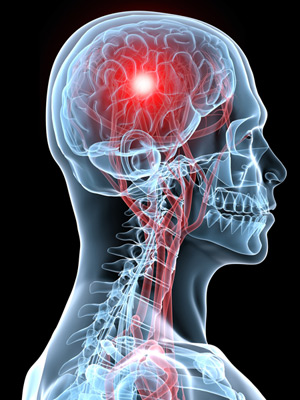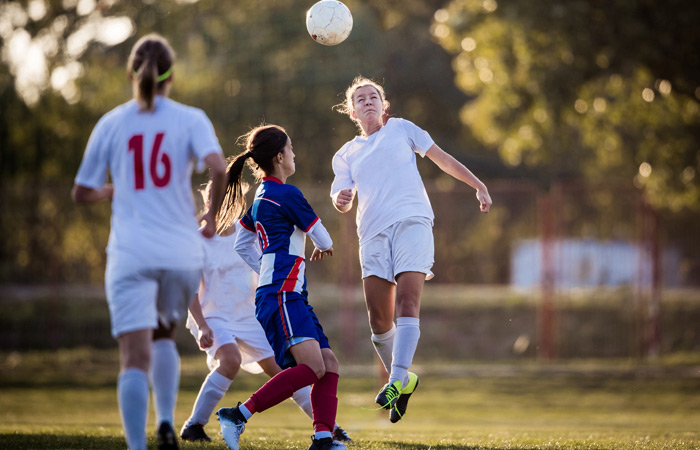 Another summer is coming to an end and it is that time of the year to start thinking about football and soccer. For fans, the long waited time of the year is finally here. For players, there is excitement to begin competition. But for some parents of student athletes, it is a time to worry about concussions and what the long the term effects of concussions are. Over the last several years, concussions have received more attention in the media, the news, movies, and even in the physician’s office. Athletic programs, whether it be high school, college, or even professional sports are taking the effects of concussion seriously, and trying to minimize the long term effects concussions can have on the athlete. For example, the Virginia Soccer Association states in Law 8 for U12 and younger divisions, “whenever the ball strikes a player in the head, play is stopped.” If the referee determines this was an intentional use of the head, then “an indirect free kick is given to the opposing team.” [1] We all know the word concussion, but what is a concussion?
Another summer is coming to an end and it is that time of the year to start thinking about football and soccer. For fans, the long waited time of the year is finally here. For players, there is excitement to begin competition. But for some parents of student athletes, it is a time to worry about concussions and what the long the term effects of concussions are. Over the last several years, concussions have received more attention in the media, the news, movies, and even in the physician’s office. Athletic programs, whether it be high school, college, or even professional sports are taking the effects of concussion seriously, and trying to minimize the long term effects concussions can have on the athlete. For example, the Virginia Soccer Association states in Law 8 for U12 and younger divisions, “whenever the ball strikes a player in the head, play is stopped.” If the referee determines this was an intentional use of the head, then “an indirect free kick is given to the opposing team.” [1] We all know the word concussion, but what is a concussion?
What is a Concussion? A concussion is a type of traumatic brain injury (TBI) caused by a blow to the head or sudden acceleration/deceleration of the brain inside the skull (known as coup-contra-coup) that temporarily changes the way the brain functions. As a formal definition of concussion, a concussion is “a clinical syndrome characterized by immediate and transient alteration in brain function, including alteration of mental status and level of consciousness, resulting from mechanical force or trauma.”[2]
Symptoms of Concussion? Some concussions are easy to observe by coaches, referees and parents, and others may be unobservable. Concussion, can, but do not always result in loss of consciousness of several seconds or several minutes. Common symptoms of a concussion are:
- Headache
- Dizziness
- Lightheadedness
- Being off balance
- Nausea
- Difficulties with vision
- Being sensitive light
- Confusion
- Attention problems
- Memory loss
Even a momentary change in functioning should be considered a concussion. If someone is hit in the head, or jars their head, and they report “seeing stars,” blacking out, or feeling as though their “bell has been rung”, even if this was only for a second, they likely sustained a concussion.
After the concussion– Many organizations have Return-to-Play and Return-to-Learning guidelines, which dictate what happens to an athlete once they have sustained a concussion. In general, after a concussion, the athlete should not return to play in the same day as the concussion was sustained (important for multi-game/day tournaments). There is a significant risk of greater harm and potentially fatal swelling of the brain if a second concussion is sustained before the brain has recovered from the first concussion (known as Second-Impact Syndrome). If the athlete has symptoms that last longer than a day, general guidelines suggest that they not return to play until their symptoms have remitted. Athletic trainers usually have a return to play therapeutic strategy for these athletes.
How to Prevent Concussions: Wearing appropriate headgear is a critical aspect to prevent concussions. While no headgear (helmet) will prevent all concussions, wearing an appropriate helmet that fits correctly is a good first step. The American Society for Testing and Materials (ASTM) has vigorous standards for helmet safety, and looking for a helmet that meets or exceeds these standards is recommended. Athletic headgear that meets these standards may will have an ATSM sticker. Helmets should be worn in any contact sport, including (but not limited to) cycling, football, hockey, horseback riding, skating/skiing/skateboarding. Make sure the helmet fits correctly and read all instructions that come with a helmet. Some helmets are not designed to withstand more than 1 impact, so a new helmet will need to be purchased once it has been compromised. Football players should listen to their coaches and learn the correct techniques for tackling. For soccer players, I would recommend avoid using your head to redirect the ball.
In future blogs, I hope to provide some of the statistics on concussions, concussion related complications, and information regarding Chronic Traumatic Encephalopathy. Please feel free to submit questions or suggestions for future blogs and I will try to answer questions as time permits.
Article by Dr. Douglas E. Grant, PhD
[1] https://www.cdc.gov/traumaticbraininjury/basics.html
[1] http://vsaonline.org/_files/rec/Virginia%20Soccer%20Association%20Laws%20of%20the%20Gamev4.pdf )
[1] https://www.aans.org/Patients/Neurosurgical-Conditions-and-Treatments/Concussion


